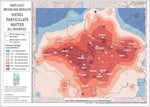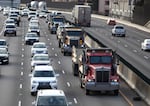A new report from Lewis & Clark Law School offers a road map for reducing diesel pollution in the Portland metro area.
Diesel pollution in Portland is more than 10 times higher than the state's healthy air benchmark. Diesel particulate is known to cause cancer and many other health problems, and it's a major source of black carbon, which contributes to global warming. But federal laws limit the city's options for reducing it.
"Under federal law, states and local governments are not allowed to directly regulate the emissions from certain types of motor vehicles," said report co-author Amelia Schlusser, staff attorney for the Green Energy Institute. "So for Portland to effectively address its diesel pollution problem, it has to come up with novel strategies. It's time to think a little bit outside the box."

A map of the diesel pollution modeling results from a 2017 study by the Oregon Department of Environmental Quality.
Oregon Department of Environmental Quality
Schlusser said cities and counties should consider reducing diesel pollution using a legal option under the Clean Air Act called "indirect source rules." They allow local governments to put pollution limits on permits for construction sites, parking lots, warehouses and rail yards.
"Indirect sources are facilities or properties that attract sources of pollution like trucks, buses, trains or ships," she said. "Other states and local governments have adopted these types of regulations, and they tend to offer a wide array of options for reducing pollution."
For example, California's San Joaquin Valley Air District requires developers to reduce air pollution at large construction sites. Developers can choose from a variety of options to reduce emissions such as upgrading construction equipment to models that emit less pollution or paying a fee to reduce emissions elsewhere.
Cities and counties can also reduce diesel pollution near schools or hospitals by setting mandatory truck routes and they can restrict the use of loading zones to reduce people's pollution exposure during the day, Schlusser said.
The "Deconstructing Diesel" report analyzes the pros and cons of the legal options available to local governments without making any official recommendations.
"We’re generally trying to provide enough information for the city and county to make decisions based on their objectives and what they identify as the most serious sources of pollution in the area," Schlusser said. "We think this is an area where local governments really need to take the lead and do everything in their authority to reduce these emissions."
Schlusser said Oregon has made some strides in reducing diesel emissions, but California has done much more. That puts Oregon at risk of being a dumping ground for the older engines cast out of California.

Oregon and Washington are expecting to receive around $185 million to spend on replacing old diesel engines through a settlement with the automaker Volkswagen.
Cassandra Profita/EarthFix
Oregon lawmakers recently passed a bill that requires diesel trucks registered in the Portland metro area to upgrade their engines to cleaner models by 2030. Diesel engines manufactured after 2007 include new technology that filters out more than 90% of harmful diesel particulate.
Kevin Downing, former Clean Diesel Program coordinator for the Oregon Department of Environmental Quality, said most of what the state has done so far to reduce diesel emissions has been voluntary engine upgrades. Many upgrades have been subsidized by state and federal funds, as well as money from the Volkswagen diesel emissions cheating court settlement.
"Our diesel emissions are astonishingly high given how we think about this state," he said. "The ubiquity of the engines themselves — there are so many of them — makes this issue challenging. They're very efficient engines, and they last a very long time."
Downing said the Green Energy Institute report could help local governments "thread the needle through some of the constraints" that have prevented more diesel pollution regulation in the past.
John Wasiutynski, director of the Multnomah County Office of Sustainability, said his agency has advocated for state-level regulation but is also working with the city of Portland to implement its own rules on diesel emissions from construction equipment used on city and county projects.
"We’ve already done the work of cleaning up our own equipment," he said. "Now, when you’re going to bring equipment to a county project it’s going to have to be clean equipment."
The idea behind the new procurement policy is for multiple government agencies to develop the same standards to send a signal to companies that own diesel equipment that public contracting agencies are going to require newer, less-polluting engines.
Wasiutynski said his agency is open to additional options for reducing diesel pollution.
"Diesel is such a potent pollutant," he said. "No amount of it is safe to breathe. We're going to be supportive of other efforts that move the needle on this."
The Diesel You Breathe
Hundreds of people die prematurely every year because of diesel exhaust. Enter a location in Oregon or Washington for a look at diesel pollution near you. View the related story.
